Related Resource
Community Remembrance Project Catalog
Learn more about EJI's community remembrance work.
124 results for "Prison"
EJI supports efforts to locally memorialize documented victims of racial violence and to educate communities about the history of racial injustice.
EJI works with communities to install historical markers that acknowledge lynchings, like this one in Tuscaloosa, Alabama.
As a law office, the Equal Justice Initiative has been dedicated to representing clients sentenced to death and condemned to die in prison, challenging inhumane conditions of confinement, and working to expose racial bias in the criminal justice system for more than 30 years. This work has provided a first-hand view of the many ways our nation’s current era of mass incarceration is deeply rooted in America’s history of racial injustice, and has inspired us to launch a project documenting and memorializing the eras of enslavement, racial terror lynching, and segregation.
That project has yielded research and public education materials—including reports, videos, interactive websites on the history of racial terror lynching and segregation, and our A History of Racial Injustice calendar—along with the groundbreaking Legacy Sites in Montgomery, Alabama.
We also believe it is critical for communities across the country to do the difficult work of unearthing and confronting their own histories of racial injustice, while exploring how that history continues to shape the present. We are honored to support community memorialization work through the Community Remembrance Project, which is organized at the county level. A meaningful aspect of this work is the opportunity for individuals to connect with members of their local community and to examine personal connections to the legacies of racial terror. EJI believes this is most impactful when done locally, allowing participants to look beyond their immediate community ties, while exploring local connections to the narratives of racial terror lynching.
EJI’s Community Remembrance Project supports coalitions in their efforts to memorialize documented victims of racial violence throughout history. The Historical Marker Project erects narrative markers in public locations describing the devastating violence, today widely unknown, that once took place in these locations. Since 2015, the Community Remembrance Project has supported local communities across the country to install more than 80 historical markers, collect soil from approximately 700 locations where racial terror lynchings took place, and judge Racial Justice Essay entries for over 900 high school students.
More than 80 historical markers have been installed in local communities since 2015.
Communities have collected soil from about 700 sites of racial terror lynchings.
More than 900 high school students have submitted Racial Justice Essay entries.
EJI is currently working with over 200 coalitions across the country. The work of these communities is honored in an exhibit at the National Memorial for Peace and Justice. These projects and the other engagement efforts help communities to understand the truth of our nation’s history of injustice, to recognize the experiences of Black communities across the generations, and to expose the ways in which the history of racial injustice continues to impact communities today.
We are very proud of the Community Remembrance Project and honored to work alongside community partners throughout the country who are taking on the challenging, necessary work of telling the truth about our history and building a future rooted in justice. Please explore this page for more information and details on how you can get involved.
After slavery was formally abolished, lynching emerged as a vicious tool of social control to reestablish white supremacy and suppress Black civil and human rights.
More than 4,400 African Americans were lynched across 20 states between the end of Reconstruction in 1877 and 1950. Racial terror lynchings were more than just hangings. They involved groups of white people committing acts of fatal violence against African Americans to instill fear in the entire Black community. These lynchings were frequently carried out in broad daylight and perpetrators could expect impunity. Government officials frequently turned a blind eye or condoned the mob violence. This era of racial terrorism shaped the geographic, social, and economic conditions of African Americans, and America as a whole, in ways that are still evident today.
Lynching and racial violence fueled the forced exodus of millions of Black people as refugees from the South into urban ghettos in the North and West during the first half of the 20th century and created a social environment where racial subordination and segregation was maintained with limited resistance for decades. Many Black refugees and exiles who fled the American South faced marginalizing and disadvantaged circumstances in the urban North, West and Midwest. Black people who remained in the South faced continued threat, terror, and humiliation rigidly maintained by legalized racial segregation. The violence and terror of lynching created a legacy of racial inequality that has never been adequately addressed in America, and continues to sustain racial injustice and bias.
Public acknowledgment of mass violence is essential not only for the victims and survivors, but also for perpetrators and bystanders who suffer from trauma and damage related to their participation in systematic violence and dehumanization.
Many communities where lynchings took place have erected monuments recognizing the Civil War, the Confederacy, and white Southerners’ violent retaking of local power after Reconstruction. But very few monuments or memorials address the history and legacy of lynching, and most victims of lynching have never been publicly acknowledged.
In Lynching in America: Confronting the Legacy of Racial Terror, EJI characterized and cataloged racial terror lynchings and studied the locations of lynching so community members across the nation could discover their local history. Our report has now been read by thousands of people who have expressed a desire to engage more thoughtfully on what the legacy of lynching represents in America.
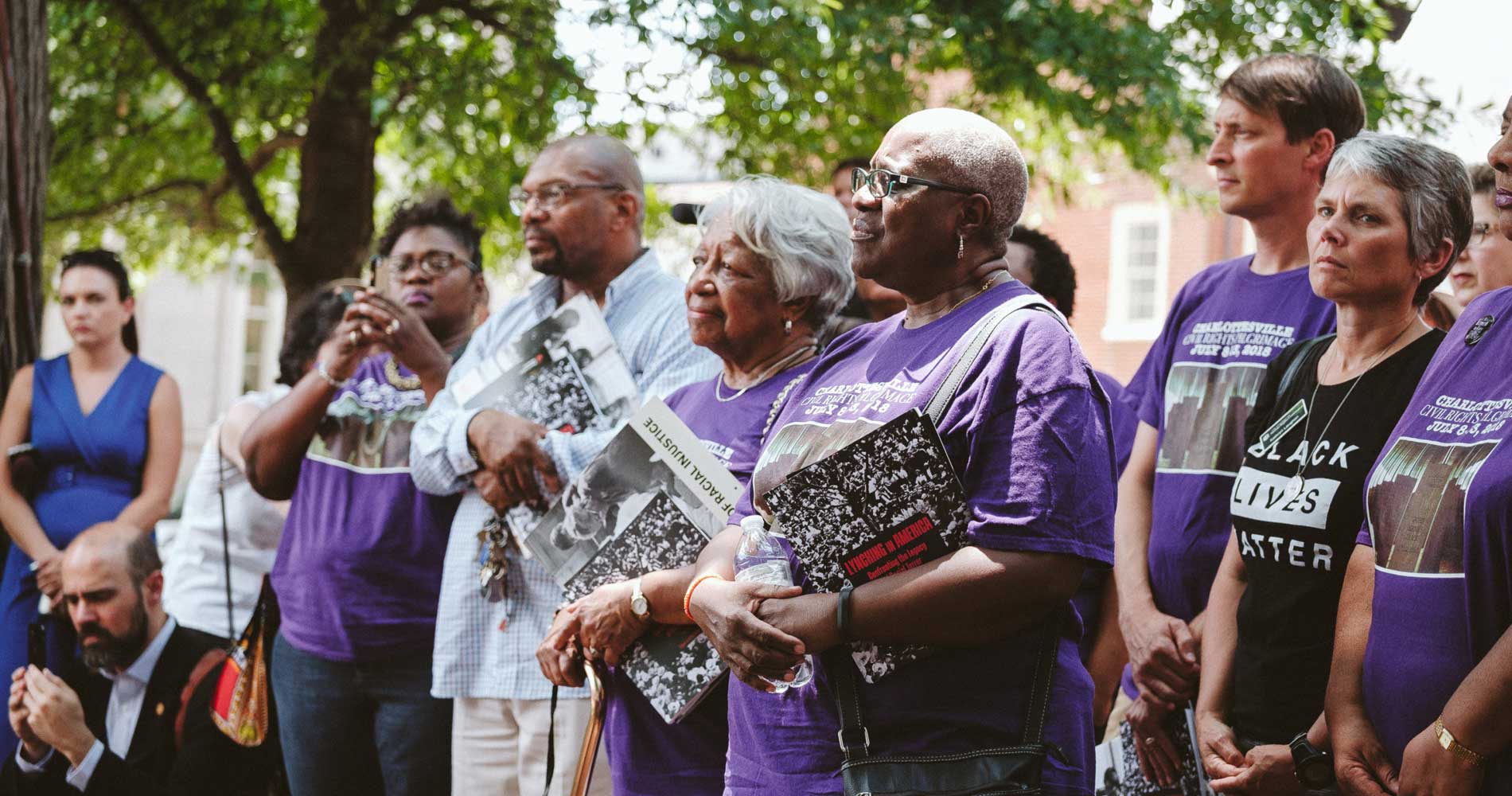
Community members gather with EJI material, including our Lynching in America report, at the July 2019 historical marker dedication ceremony in Charlottesville, Virginia. (Eze Amos)
To create greater awareness and understanding about racial terror lynchings, and to begin a necessary conversation that advances truth and reconciliation, EJI is working with communities to commemorate and recognize the traumatic era of lynching by collecting soil from lynching sites across the country and erecting historical markers and monuments in these spaces. Explore a map of the counties documented in EJI’s research on our interactive microsite.
We believe that understanding the era of racial terror is critical if we are to confront its legacies in the challenges that we currently face from mass incarceration, excessive punishment, unjustified police violence and the presumption of guilt and dangerousness that burdens many people of color.
EJI’s Historical Marker Project invites community coalitions to confront historical trauma and advance truth-telling at the local level.
The narratives of racial difference created to justify centuries of enslavement persisted long after slavery was formally abolished. Black communities continued to face violent intimidation as Black men, women, and children were lynched for minor social transgressions or for asserting their civil rights, and were assigned a presumption of guilt and criminality. When the era of racial terror lynchings ended in the mid-20th century, it left behind a nation and an American South fundamentally altered by decades of enslavement, cruelty, and systematic community-based violence against Black Americans. These legacies have yet to be fully understood.
As part of our effort to help communities confront and recover from tragic histories of racial violence and terrorism, EJI is joining with communities across the country to install narrative historical markers at the sites of racial terror lynchings. Historical markers are a compelling tool in the creation of a permanent record of racial terror violence that provides everyone in the community exposure to our shared history of racial injustice. EJI’s historical markers detail the narrative events surrounding a specific lynching victim, or group of racial terror lynching victims, and the history of racial terrorism in America.
Through the Historical Marker Project, local communities are motivated to confront historical trauma that is both universal and also very specific to the Black experience. EJI’s Historical Marker Projects are led by community coalitions that include individuals representing a diversity of experiences and affiliations in the local community. EJI believes that reckoning with the truth of racial violence that has shaped our communities is essential for healing.
Local community members interested in pursuing a Historical Marker Project should first commit to reading in full EJI’s Lynching in America and Reconstruction in America reports as a foundation for understanding the historical context of racial terror violence. We also strongly encourage community members to plan a visit to the Legacy Sites in Montgomery to further engage with America’s history of racial injustice.
Email us for more information about our Historical Marker Project
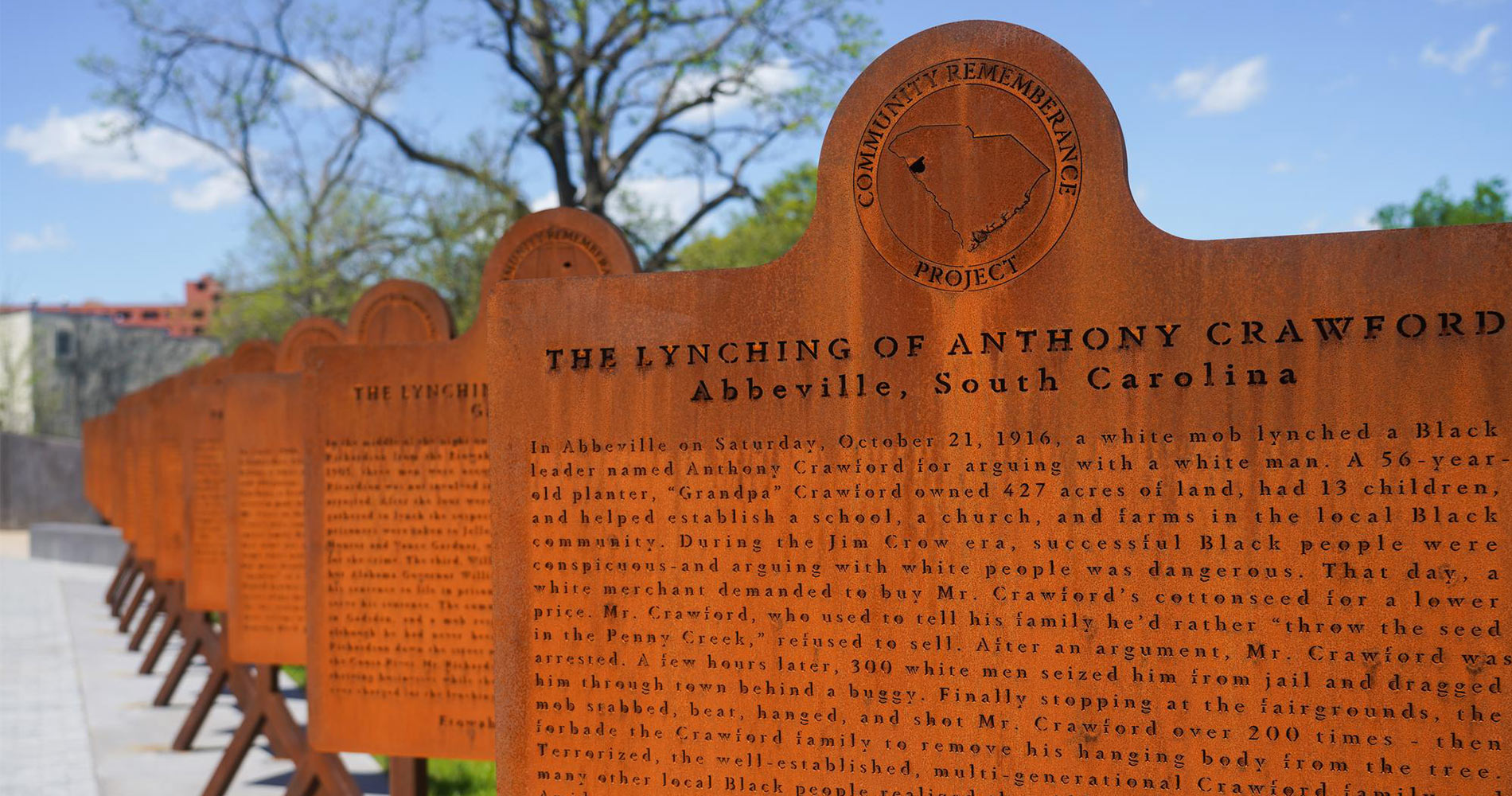
An exhibit at the National Memorial for Peace and justice with replicas of historical markers erected across the country.
To recognize the important work of local communities, EJI has created an installation at the National Memorial for Peace and Justice, honoring the work of community remembrance coalitions around the country to erect local historical markers commemorating lynching victims. The exhibit includes more than 70 copper replicas of historical markers, each of which provides a detailed narrative about specific racial terror lynchings. This exhibit is a dynamic reflection of local commitments to overcome silence about the legacy of racial injustice, which will continue to grow as communities erect additional markers.
EJI believes that truth and reconciliation are sequential. We must address oppressive histories by honestly and soberly recognizing the pain of the past.
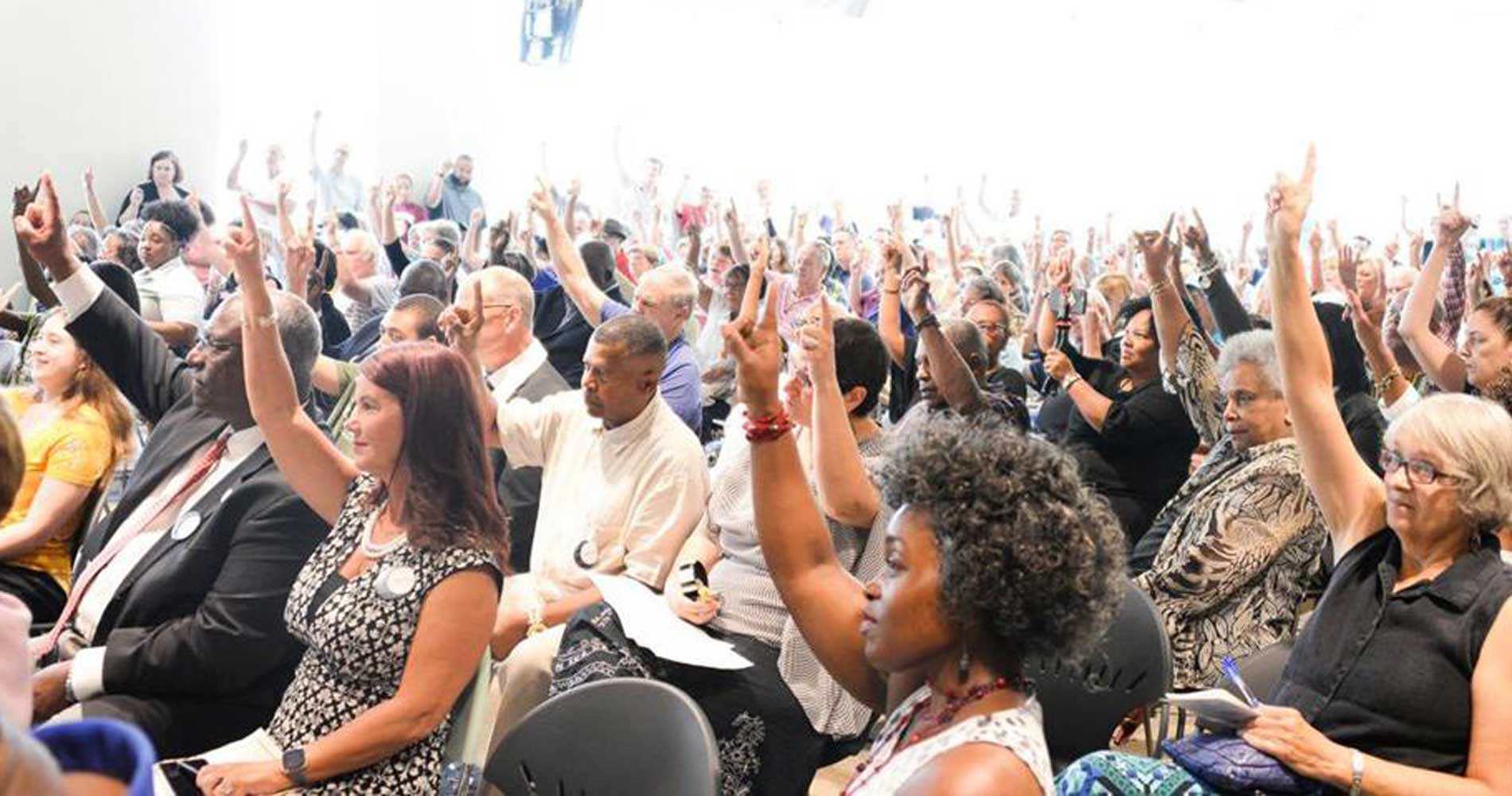
Community members in Franklin County, Kentucky, gather to remember victims of racial terror lynching in their community.
To repair the harms caused as a result of the eras of enslavement, racial terror lynching, segregation, and mass incarceration, we must commit ourselves to building an era of truth and justice. EJI invites communities to contribute to this effort by deepening their understanding of the history of racial injustice and by providing tangible opportunities to participate in restorative truth-telling.
Community education and engagement create opportunities to explain the effects and ongoing legacy of racial terror violence. EJI believes the most impactful educational opportunities occur as a result of engagement in the local community.
EJI has published numerous detailed research reports and public education materials that provide a foundational backdrop for those seeking to understand America’s history of racial injustice.
Research on the Transatlantic Slave Trade examines the ways in which coastal communites from Maine to Texas have been shaped by the kidnapping and trafficking of millions of African people. An additional report on Slavery in America details the importance of the Domestic Slave Trade across the South.
EJI has documented at least 2,000 victims of racial terror lynching from the Reconstruction Era immediately following Emancipation, between 1865 and 1876. The Reconstruction in America report details the failure to commit to establishing racial equality in the aftermath of the Civil War, ultimately setting the stage for an era of racial terror during which lynching violence was used to terrorize Black communities and maintain racial hierarchy. The Lynching in America report further details at least 4,500 people who were victims of documented racial terror lynchings from 1877 to 1950. An interactive map also details this research, showing the number of documented lynchings in counties across the country.
EJI’s Segregation in America report examines the effects of massive resistance to desegregation by millions of white Americans, particularly during the Civil Rights Movement. An understanding of this opposition is critical to efforts to address the ongoing challenges of racial injustice.
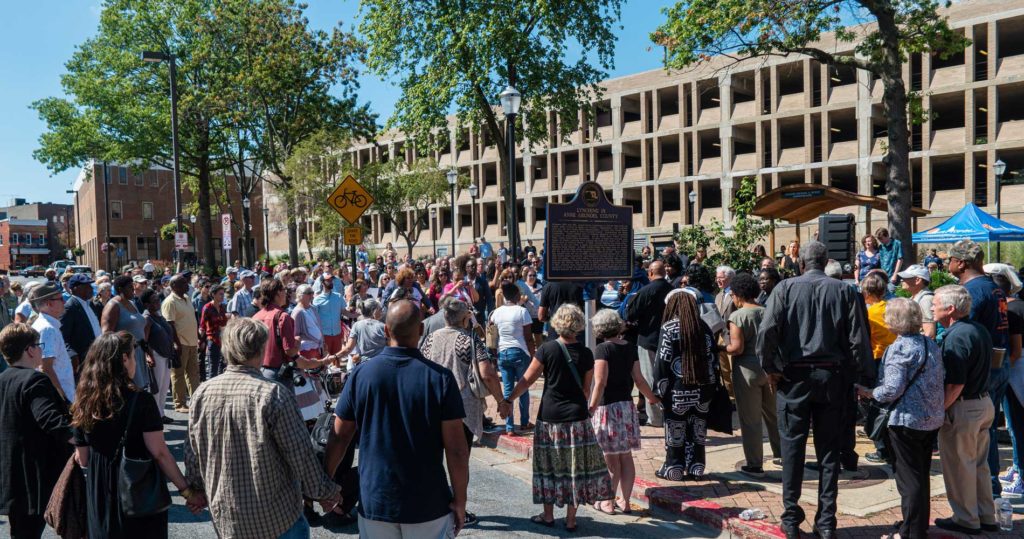
/
In Annapolis, Maryland, in September 2019, hundreds dedicated a historical marker commemorating five African Americans killed in racial terror lynchings.
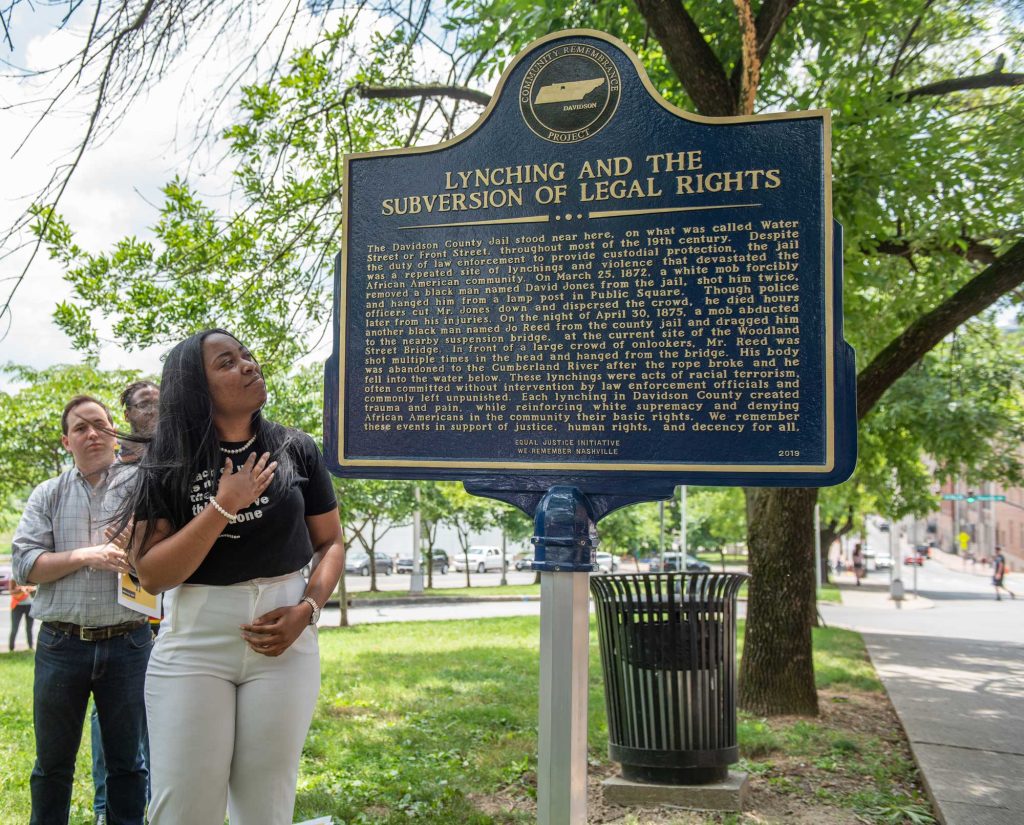
/
Community members dedicated two historical markers in Davidson County, Tennessee, in June 2019.
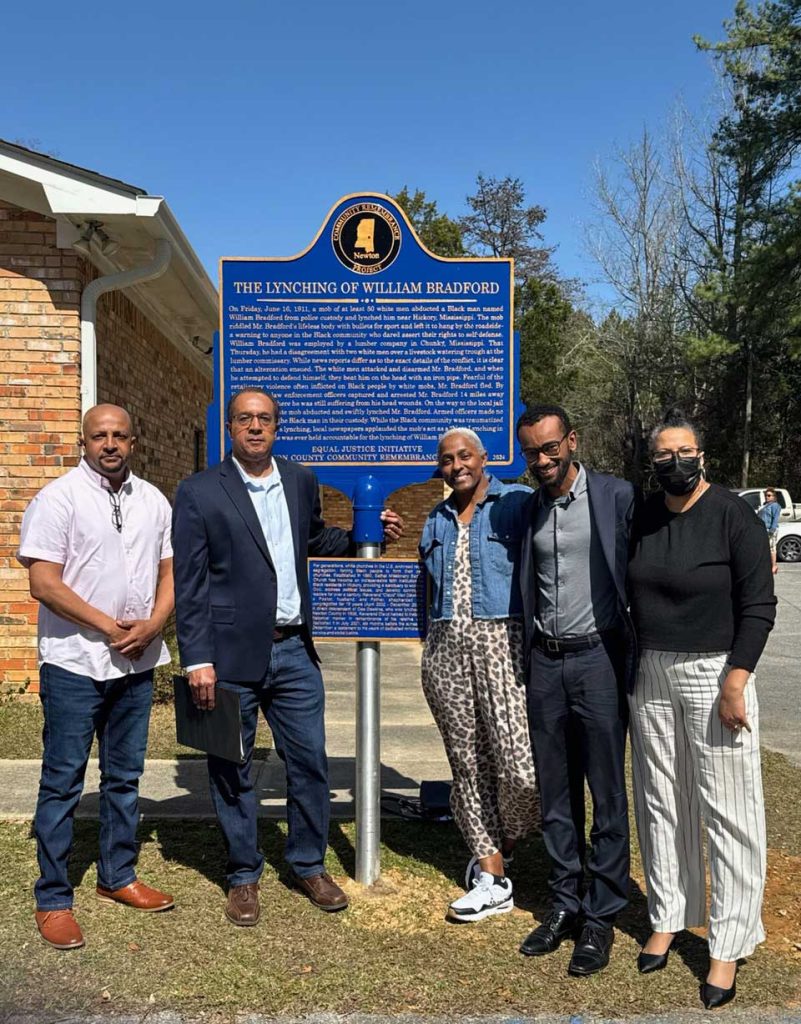
/
Community members in Newton County, Mississippi, gather to dedicate a marker honoring William Bradford.
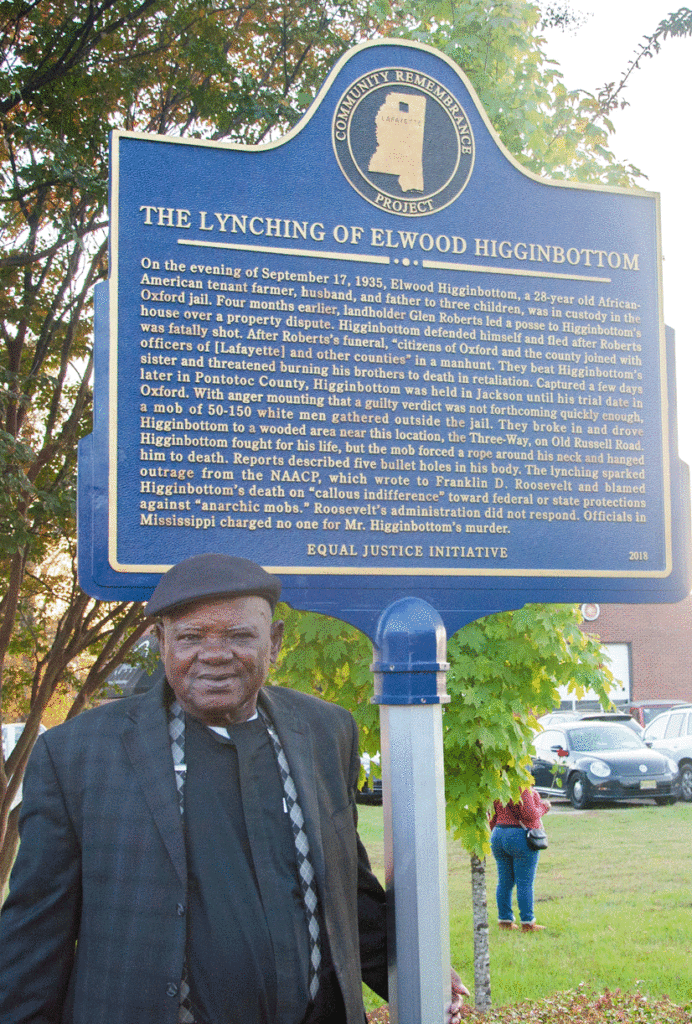
/
E.W. Higgenbottom participates in marker dedication acknowledging the lynching of his father, Elwood Higginbottom, in Oxford, Mississippi, in 1935.
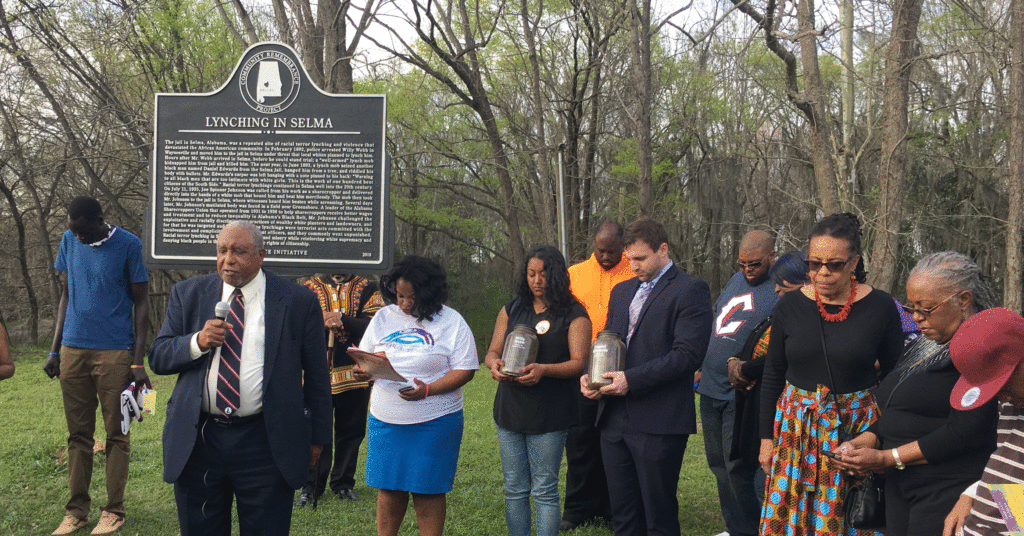
/
Dr. Bernard Lafayette prays with community members in Selma at the marker dedication of a marker recognizing three victims of racial terror lynching in Dallas County, Alabama.
EJI sponsors an essay contest for public high school students. Students in grades 9-12 are challenged to research and write an essay reflecting on a historical event and its connections to present-day issues and their lived experiences. EJI selects several winners from across the county and typically awards at least $5,000 in scholarships and prizes. The winners are announced at an awards ceremony held in the community.
Community Soil Collection Projects provide tangible opportunities to engage and reckon with the legacy of racial terror lynching.
In 2015, EJI began working with communities across the country to commemorate and recognize the traumatic era of racial terror by collecting soil from lynching sites. The Community Soil Collection Project provides a tangible way for community members to confront the legacy of racial terror lynchings and to memorialize the Black victims whose lives were lost and the communities impacted by such violence. The Legacy Museum in Montgomery includes an exhibit of 800 jars of soil collected from lynching sites across the country.
In this soil, there is the sweat of the enslaved. In the soil there is the blood of victims of racial violence and lynching. There are tears in the soil from all those who labored under the indignation and humiliation of segregation. But in the soil there is also the opportunity for new life, a chance to grow something hopeful and healing for the future.
–Bryan Stevenson, EJI Executive Director

/
The Legacy Museum displays 800 soil collections from around the country.
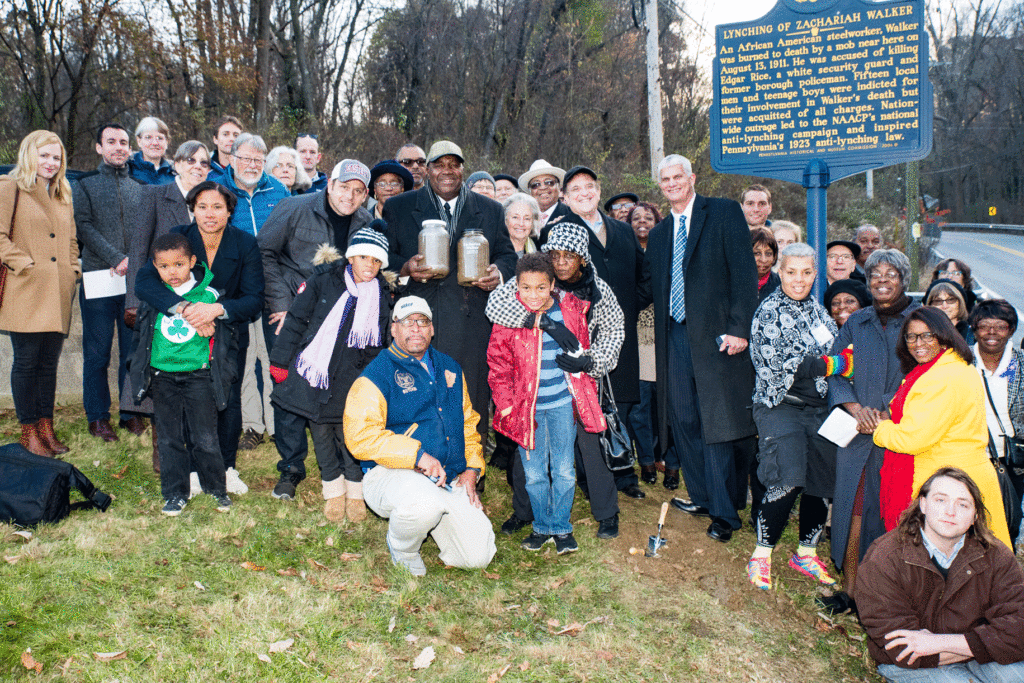
/
Community members in Coatesville, Pennsylvania, gathered in November 2017 for a soil collection ceremony to honor the life of Zachariah Walker, who was lynched in 1911.
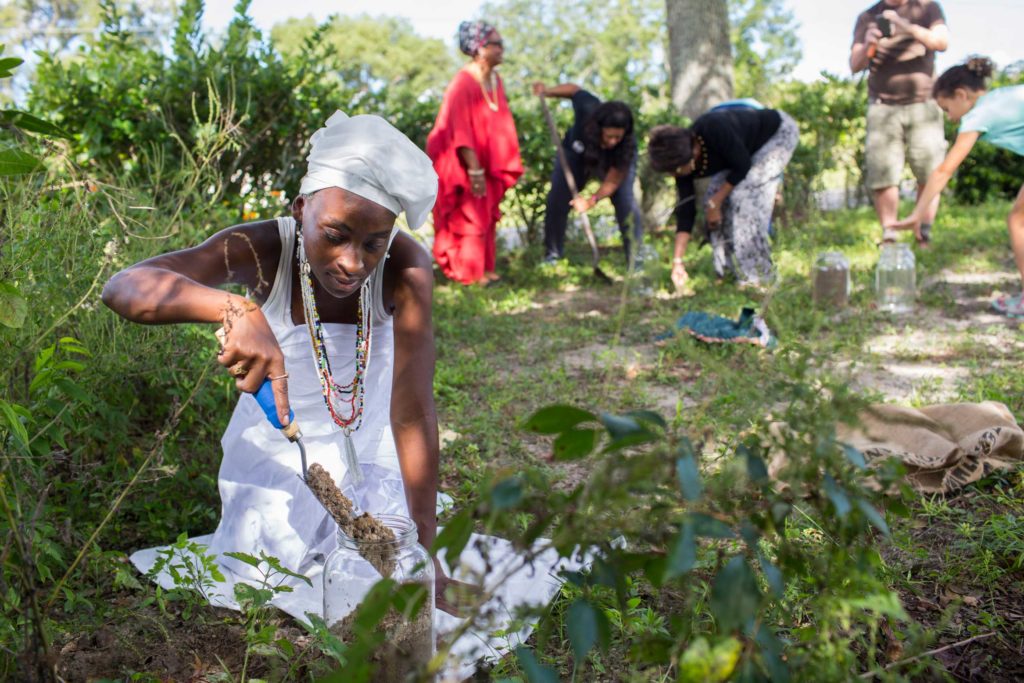
/
Soil collection in Orange County, Florida, in September 2018.
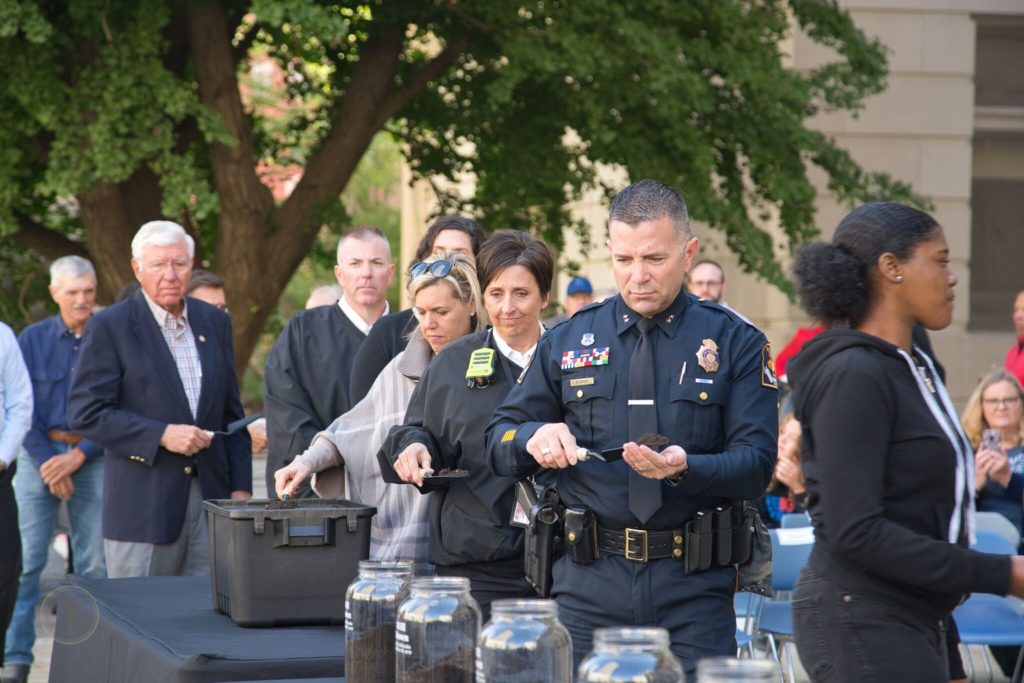
/
Hundreds of people gathered at the Douglas County Courthouse in Omaha, Nebraska, to remember the September 1919 lynching of Will Brown.
Markers placed in local communities should be accompanied by increased local consciousness about this past and its legacy.
Established in 2018, the Legacy Museum explores the history of racial inequality and its relationship to a range of contemporary issues from mass incarceration to police violence.
The Legacy Museum examines the development of narratives of racial difference beginning with the Transatlantic Slave Trade, through eras of lynching, segregation, and present-day mass incarceration. It offers a rare opportunity for visitors to explore the history and legacy of racial injustice in the United States through detailed research and presentation of first-person narratives through visual and interactive exhibits.
The National Memorial for Peace and Justice provides a sacred space for truth-telling and reflection about racial terrorism and its legacy.
The memorial recognizes the over 4,500 documented racial terror lynchings that occurred across the United States between 1877 and 1950. Additional memorial sites honor documented victims of racial terror violence from the Reconstruction Era (1865-1876) and during the 1950s. The names of individual victims are engraved on over 800 steel monuments. In the six-acre park surrounding the memorial is a field of identical monuments, alphabetized by county and state.
Because there is a path to recovery and reconciliation when we tell the truth about our history in public, acknowledging racial harm in public spaces is a critical first step in racial reconciliation. We must address oppressive histories by honestly and soberly recognizing the pain of the past. The National Memorial concretizes the victims of racial terror lynchings in our national consciousness and makes our national landscape a more honest reflection of the history of America. We cannot repair what we cannot name.
The timeline for putting up a historical marker varies depending on your coalition’s ability to get site approval for the marker and EJI’s capacity. While a marker project often takes six months to a year to complete, we are limited in the number of marker projects we can take on at one time.
EJI provides all markers to each Coalition at no cost. We ask communities to assist with finding a site for the marker and to plan the unveiling of the marker, but EJI will handle the logistics of shipping and producing the marker.
Please refer to our County Data Supplement to find out about lynchings in your county. During the process of erecting historical markers, the EJI team provides research support and additional details about specific documented racial terror lynchings.
If you have a specific inquiry, you can reach out to [email protected] and we will be in touch as soon as we can. Please note that due to our limited capacity, our team prioritizes research support for ongoing marker projects. We also welcome outreach from descendants of lynching victims regarding additional research and memorialization efforts.
While there is no minimum number of people required, we encourage you to reach out broadly across the county and ensure that a variety of communities, perspectives, and experiences are represented. Involvement by local government is not required, and historical markers have typically been installed without government sponsorship. For additional guidance on forming a local coalition, please review our Community Remembrance Project informational booklet.